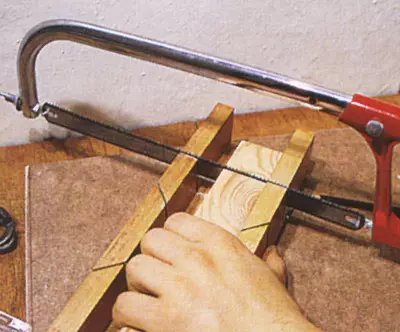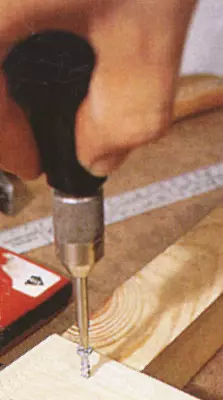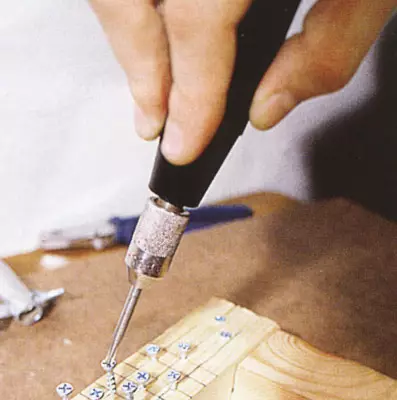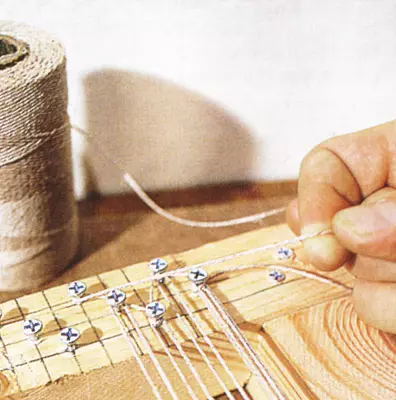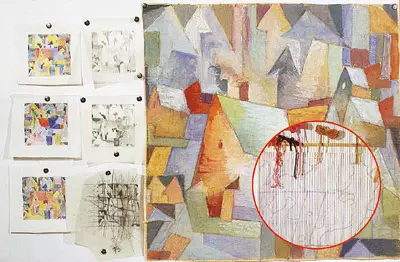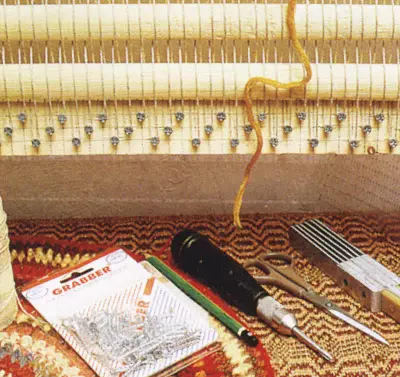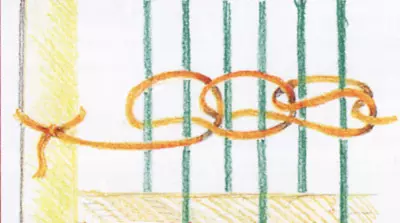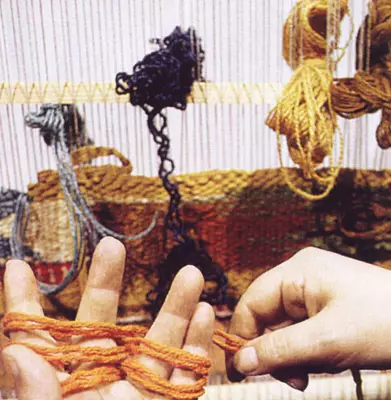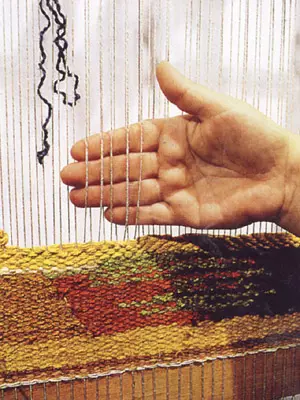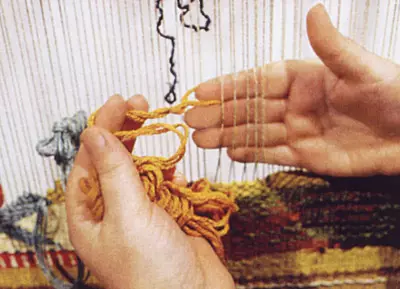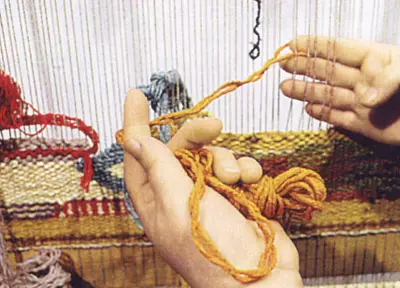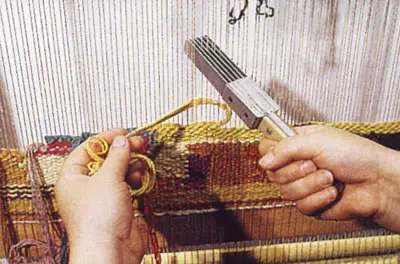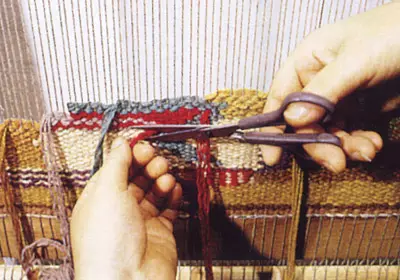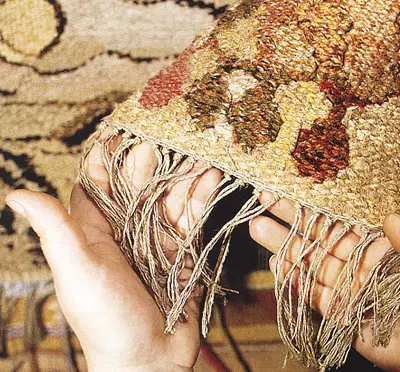"Everything in the tapestry depends on fantasy, temperament and taste ...» Basic principles for creating tapestry rugs.
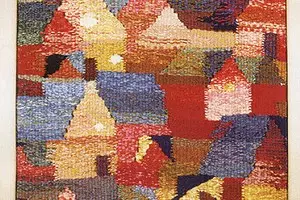
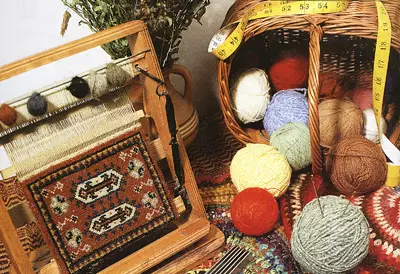
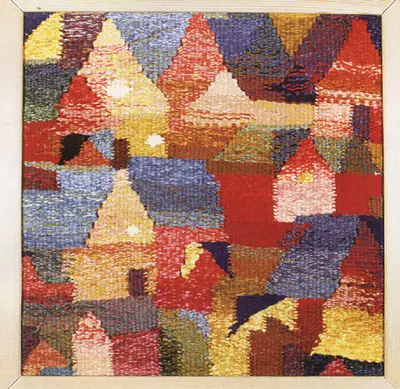
Tapestry carpets have always been popular. Hospitality, buy a ready-made weaving machine, the problem, cooked bars, rails and planks, as well as screws will help us out in this situation. Of course, you need a desire and patience, without which you do not make a lot on the real weaving machine. To work, we will need: 4brusk 55cm about 1,5m long, three staks on the meter each, cardboard 1.51.5m, carton, watercolor or gouache, two packs of screws (you can replace the screws with nails, less aesthetic, but cheaper), filaments , so-called mock, and different woolen threads, better "carpet."
Introduction
When everything you need is suitable, we begin to make a frame with the calculation so that it is at least 3-4 cm in width and by 40-50 cm in length more of the alleged carpet size. Vertical bars frames can be 55 (44) cm, horizontal 510 (410; 44) cm, for the convenience of fastening the base screws. The frame is tightened with metal bolts with a diameter of 8-10mm. If you make a small frame, as in the present example, you can strengthen its screws. It is also advisable to attach triangles from the six-layer plywood on the rear side of the frame to the corners (screws 2 cm or nails with a length of 3 cm). When building the simplest frame, the material for bars can be birch, but necessarily dry. In the opposite frame case, hanging, turns.To mount the base on the frame, you should drive into the upper and lower bars of nails or screw the screws, pre-applying markup: in the present example, the screws are fixed three in a row diagonally. To do this, we divided the width of the timber to three equal strips, and along the same horizontal strips through 1cm caused cross division. Screws screwed up the lines. At the same time, if the carpet is small, you can draw the basis on the frame of solid thread. So, the two filaments of the foundations are attached to one nail. If the carpet is large, you need to drive the nail for each thread. With this method, each thread of the base is attached to the frame separately and there is no connection between them. The diagonal fastening of screws is caused by the bars that the bars do not crack, and pull the base thread so more convenient.
The base is fixed on the first screw from the bottom and each time stretched upwards are turned upside down around the screw, thus we achieve the tension of the thread, which contributes to the formation of the carpet density. On the first screws, the thread is wound 5-7 times in order to form the edge roller.
Behind the tension of the base on the frame should weave the Lower Berdo (special nodes tied thread to strengthen the lower edge of the tapestry). For the manufacture of berped usually takes linen cord-mock. One end is tied to a frame of a frame with one of the sides. A chain is made from reaching a cord with a cord with a cord, a chain is made, through each link which the base thread passes. Beardo must remain tightly stretched between the side bars of the frame, only at the same time it is possible to obtain a good homogeneous carpet surface.
Berdo has from the lower edge at such a height, which is needed to later tie a long bug. Before making a boro, it should be stronger to stretch the basis with the help of transverse planks. To do this, first we draw through the entire basis, alternating thread, the first bar, and then the second with the reverse alternation, they will support the fabric, and the bases of the base will be easier to separate apart from each other, without being joining them.
Thickness of threads for rebel depends on the thickness of the bases of the base. Berdo loop, made of overly thick material, takes plenty of space between the two threads of the base, and therefore it is impossible to keep the base with it horizontally stretched. Berdo, made of overly thin material, requires the correct density of the base of additional loops between its threads. It is uncomfortable for working simply. Night bases at the same distance from each other.
Then the third smooth rail or a round stick of a small diameter, a slightly longer frame width, they have merged between the base so that the odd threads are on the stick, and even under the stick. The intermediate rail holds due to the tension of the bases of the base at the top of the carpet. Thus, the main action is prepared ...
Vazka
Weave the carpet starts from the edge, which, when the carpet is ready, is separated or dissolved. Mostly use a light woolen thread. The filament of the duck-special Gulk is wateted to the eight of the fingers of the left hand into a small tangle, which is fixed through four to five turns, the end of the thread pushed under the last round. Tangle-ducks unwind from the beginning of the thread.
One hand "open" the first gap with a length of about 10 cm, "picking up" the base of the base from below, and the other push into the resulting clearance of ducks. Stayed in the interval, the material of the duck-wool or linen filament is riveted with a weaving paw or a large heavy fork. Then, again, dialing the basis from the bottom, lead the thread from the duck back. Again, putting the thread of a weaving paw, lead a straight strip of the same color in the third time.
| Make the hacking cut to half a bar, retreating from the edge to the width of the bar. Using the hammer and the chisels, make a groove on each side. Operation Repeat 8 times along the edges of the frame. | |
| Screws (3-millimeters) or bolts with a diameter of no more than 8-10 mm secure the frame at the corners. For strength, screw the corner from plywood on the reverse side of the frame. | |
| Applying the markup on the frame (three horizontal stripes separated by transverse lines through a centimeter), screw the screws diagonally to three. | |
| This stage relates to rather and prepare the basis of the fastening of the threads on the screws. Catching the first two screws 5-6 times, you begin to urge the filament of the base sequentially two turns on the screw, pulling the thread. | |
| To begin with a small sheet (so obviously integrity) watercolor is written sketch-ideas. Beginners we will advise graphic solutions. Then two trackers are made from this sketch. Both are working on lines and details of the future carpet. The best shall be divided into squares on a centimeter and transferred on scale. Scale is calculated relative to the specified frame size. Cardboard sketch is fixed on the frame behind the base using the buttons. For it, it is possible to use millimeter paper, and it is not necessary to color it, suddenly you will come to change the colors of the carpet or you will not have a thread of the desired color. | |
| Before reaching the Birdo, it is necessary to turn through the bases of the base, alternating the thread, two strips. Immediately after you pulled a borroid and secured it on the frame, you upset the first one-color row. You feed each row of weaving paw or heavy fork. | |
| Berdo thread stretches from the left beam "knitting crochet" - a chain is obtained, on each link which the base thread is inserted. | |
| The material for a duck can serve a wool thread, synthetic, silk, flax and many other materials. The eight of the fingers are winding the thread and fastened after 4-5 turns. If she blossomed or kept loosely, and it already inserted into the base, it is not necessary to break the carpet, it is enough to bandage the remainder of the thread in exactly the same way. | |
| Berdo thread stretches from the left beam by the way "crochet" - the chain is obtained, on each link which the base thread is inserted. | |
| One hand "open" the first gap with a length of about 10 cm, "picking up" the base of the base from below, and the other push into the resulting clearance of ducks. This operation is repeated throughout working with tapestry. Thread is held due to the effect of "basket" - alternating the filaments of the bases and the yarns of the duck. The end of the thread must be left outside it will be easier to cut it. The thread, not even tied to the base of the carpet, will not fall, if we kill with weaving paws. After part of the tapestry is ready, you can cut the threads. |
|
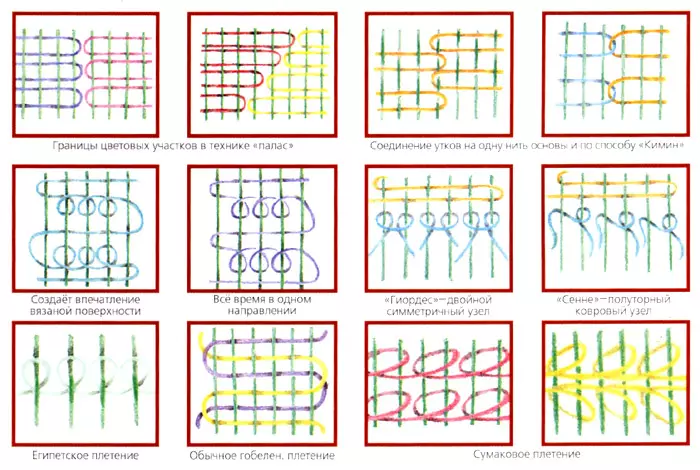
| Combinations of technical solutions and different types of nodes can only decorate your creation. The simplest effects are laying vertical columns and laying with different colors of horizontal strips. If you wish, you can invent other ways or use the effects presented in the drawings. | |
| The edge of finished work can be left with a fringe, and you can not remove the product from the frame and leave as a picture, additionally acquiring a simple baguette. |
Basic action
The lower edge of the carpet is intertwined by the thread of one color by 3-5 cm in height. There is a working drawing of a cardboard that is attached by thin contour lines or in the color of the conventional drawing of the future carpet. Next, we upset the drawing, following our sketch by the same technology. The threads stretched in the second alternation are intertwined by a ledge that occurred at the first turn back. Thus, the carpet is being concession to another edge.Usually the carpet of the Tkut in width (in the case of the case, the cardboard is fixed with a rotation of 90), but can be weave in length, as in our example. Especially when there are many vertical on cardboard. Carpet Tkut on working drawing. Separate parts of the carpet can weave centimeters 20 above woven surfaces. If it is not possible to fill in a timely intermediate surface, the carpet is easily narrowed.
In the tapestry, it often happens that there is no connection between thefts of the ducks in the places of the flower transition, the threads themselves hold the product, and in the event that the clearance is formed between the disinanted surfaces, they can be copp with each other with a seam . A separate duck thread wrap around one thread of the bases where the color surfaces are adjacent.
Culmination
In classical tapestries, a relatively thick, dense base and a thin thread of ducks are completely covered with the base and the surface of the carpet is homogeneously dense and smooth. The non-traditional approach allows to diversify the texture that is obtained using together or various materials or various weaving techniques. In this case, a rough and thick base is underlined with such a calculation so that in the carpet and the material of the base that gives the tissue is a kind of charm. Along with traditional duck materials - silk and wool threads, other natural fibers (flax, leather, cotton, panel, sisal, manila, jute, etc.) are also used, synthetic fibers, metal thread, fabric strips, sliced stockings strips And much more, at the request of the "examining". The material of the duck, woven between the basis, can be both the same thickness and different thickness. Some surfaces are thin, other - much rougher, smooth surfaces can be alternating with darous; The modest matte surface is located next to the shiny, of silk or metal.
The formation of the texture is composed of several technical solutions - different weaving, drawings of the nodes of the confusion. We offer for beginners several examples: connection of nodes for one thread of the base, the connection of ducks, the boundaries of the color plots, the usual tapelet weaving, the closure of the milestone (creates the impression of the icing surface), Egyptian weaving - when using thick yarn, such a surface looks like it is composed of vertical rows Bead.
The operation ends with the upper edge of the canvas, which should be the same width and thickness with the bottom. Berdo is touched on top, which is dragged to the removal of the carpet and thereby prevents the dissolution of the duck threads during the cutting of the bases of the base. Before removing the threads, cut off, cut off. Threads, well-nailed with weaving paws, cannot dismiss. Cutting the bases are carried out by retreating the frame from below to the screws, on top of the same distance; The filaments of the two are binding to elegant fringe. The carpet is stretched on the floor or a large frame and nailed along the edges of nails, cover with a wet cloth, and in a day, when the tissue will dry, it is removed. Freeing from tension, the lower and upper edges are tested, hide the nodes to them and take it, then the iron is stroked through the rag. The product can not be removed from the frame and put in the baguette, having received a tapestry picture.
Junction
Correct to leave the open finale and do not put morality issues, and even more so not to impose your decisions. Make a carpet without a machine and special skimming forces, believe me.'' Everything in tapestry depends on fantasy, temperament and taste ... ''
We were asked to give a few tips for beginners to Alexander Yuryevna Smirnov-Galchenko: "It's nice that you turned to this topic, I believe that for many it is an opportunity to realize your abilities and fantasies. Yasama is a non-professional artist, although he studied in many famous authors, for example Urbruskin. Work on tapestry attracts little due to high laboriousness, so in this technique there are mainly monumentalist professionals. However, if it becomes a hobby, it can exit a lot. Iniquit about the housewives always hit me with your handmade tapestries. A small job can leave the estes, and two- labor is considerable. The result exceeds expectations. New, interesting.
Beginners, I would advise the first carpet to do on the frame, it should be simpler, without long vertical lines. For a duck, it is better to use only a woolen thread, as it is easier to maintain the material from the beginning and to the end the same carpet width. Avot in the following carpets can already use various ways of weave and enrich how much the surface of various materials. Each new job helps to gain experience, courage, gives rise to new ideas. "

